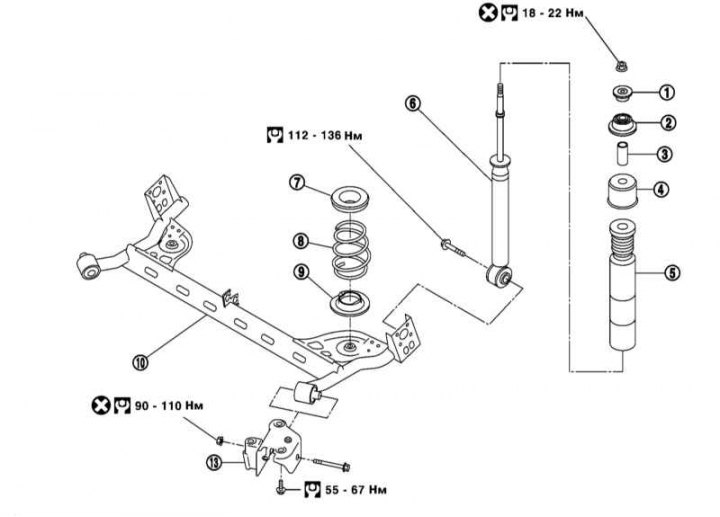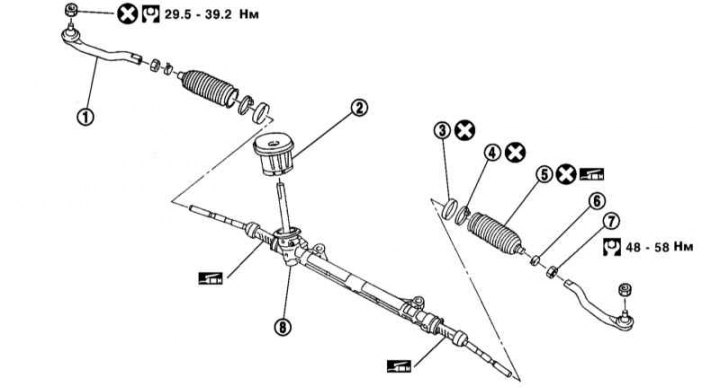Front suspension

1 - Upper spring plate; 2 - Bearing; 3 - Helical spring; 4 - Boot; 5 - suspension strut; 6 - Swivel fist; 7 - Clamp; 8 - Bushing; 9 - Stabilizer bar; 10 - Cross lever; 11 - Stabilizer; 12 - Top link (only models with AT); 13 - Top link; 14 - Subframe; 15 - Rack subframe
Front suspension cars Nissan Micra K12 independent, with MacPherson struts, wishbones and anti-roll bar. The bearing elements of the front suspension is a beam connected to the body by bolts. Both transverse levers are fixed on the beam, which in turn are connected by bots to the steering knuckles. The suspension struts are also mounted on the steering knuckles. The hub and wheel bearing cannot be adjusted or repaired.
Rear suspension

1 - Emphasis; 2 - Bushing; 3 - Spacer; 4 - Anther cover; 5 - Bellow; 6 - Shock absorber; 7/9 - Upper/lower spring seat; 8 - Helical spring; 10 - Cross beam; 11 - Suspension arm bracket
Rear suspension dependent, with shock absorbers and coil springs separately mounted on the beam.
Steering column

1 - Steering wheel; 2 - Assembling the steering column with the EPAS control unit, e / motor, reduction gear and sensor; 3 - Intermediate shaft; 4 - A bolt of fastening of an intermediate shaft to a steering column
Steering gear with rods

1 - Tie rod end; 2 - Bulkhead seal; 3 - O-ring; 4 - Clamp; 5 - Bellow; 6 - Spring ring; 7 - Locknut; 8 - Assembly of the steering mechanism
Steering rack-and-pinion, with electric booster (EPAS). The driver's front airbag is installed in the steering wheel. The steering mechanism has no backlash and does not require maintenance, except for checking the condition of its anthers, as well as the anthers of the tie rod ends.
Loosening problems often occur when repairing or servicing suspension and steering components «stuck» bolts and nuts. Fasteners located under the bottom of the car are constantly exposed to external influences and eventually corrode and partially collapse. The use of brute force in releasing such «stuck» fasteners are at risk of damage. To begin with, wet the non-retractable element with a small amount of special penetrating liquid, allowing it to soak the rust layer well. Use a wire brush to remove external deposits from the accessible areas of the threaded surfaces. Sometimes a sharp blow with a hammer on the nut through the drift helps to destroy the rust that fills the gaps between the turns of the threaded joint - try not to damage the threads as a result of the drift coming off. Use when giving away «stuck» fasteners of a long wrench allow you to significantly increase the applied torque, however, it should be remembered that the use of extension cords in a set with ratchet-type drives is associated with the risk of failure of the return mechanism, as well as the possibility of injury. Fasteners damaged in the process of releasing must be replaced without fail.
Since most of the procedures described in this Chapter are performed on a car raised above the ground, you should take care of the options for its reliable fixation in a raised position in advance - prepare strong props. To jack up the car, use hydraulic rolling jacks - remember that the onboard jack included in the standard package is intended only for temporary jacking up the car when replacing a failed wheel. The hydraulic jack can also be used to hang some suspension components when performing a particular procedure.
Attention! It is not allowed to carry out work under the car, which is held in a raised position only by means of jacks!
Welding and straightening of load-bearing suspension elements, as well as steering elements, is not allowed. Self-locking nuts and corroded fasteners should be replaced during repairs.